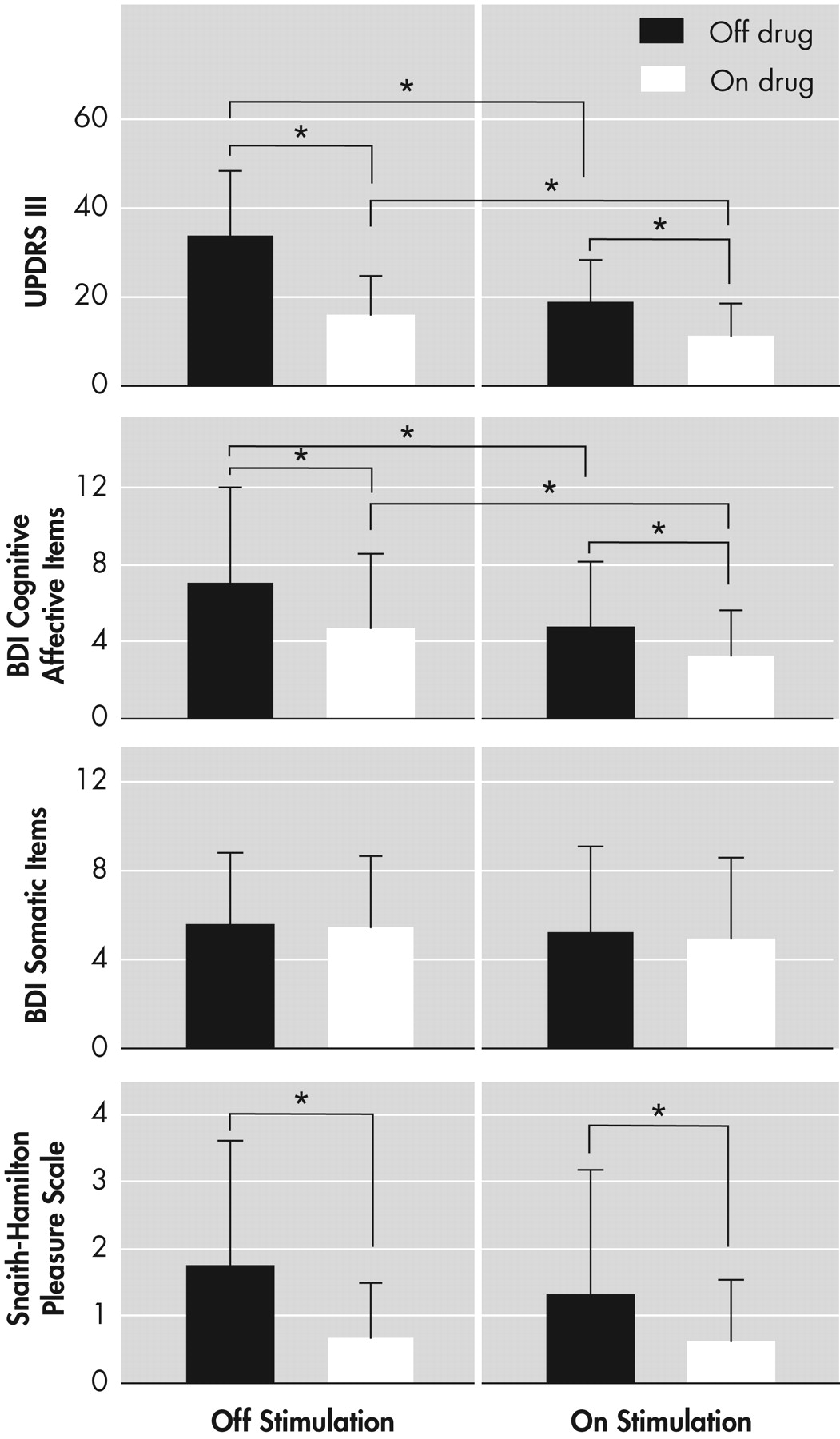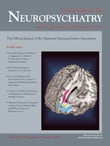N eurobehavioral disturbances constitute an important aspect in the spectrum of clinical manifestations of Parkinson's disease.
1,
2 Thirty-eight percent of Parkinson's disease patients develop depression according to DSM-IV criteria.
3 Anhedonia, the inability to experience pleasure, is a typical feature of major depression, but it is also frequently associated with Parkinson's disease. The prevalence of anhedonia in Parkinson's disease patients is 7% to 40%, but low hedonic tone is not always related to depressive mood in Parkinson's disease.
4,
5 Deep brain stimulation (DBS) of the subthalamic nucleus (STN) improves off-period motor functions in Parkinson's disease.
6 Several reports have described behavioral abnormalities in Parkinson's disease patients after DBS.
6 –
10 The interpretation of these longitudinal studies that examined patients before and after implantation of STN electrodes for DBS is complex. Behavioral problems might be the consequence of a post-operative decrease in dopaminergic medication and, therefore, might reflect the loss of psychotropic effects of the medication. Or, the reported changes in mood might be the result of specific effects of the STN stimulation itself. The goal of the present study was to investigate the effects of acute changes in STN stimulation and L-dopa on signs and symptoms of depression and on hedonic tone.
METHOD
We examined 15 Parkinson's disease patients (three women, 12 men, mean age of 57 years) before and 3 months after bilateral electrode implantation in the subthamamic nucleus for deep brain stimulation. All patients suffered from advanced Parkinson's disease (mean disease duration of 15 years [SD=4.8 years]).
Their Hoehn and Yahr ratings raged from 2.5 to 4 (mean=2.97 [SD=0.35]). None of them exhibited dementia (Mattis Dementia Rating Scale score >130).
11 The patients had quadripolar stimulating electrodes chronically implanted, as previously described.
12 Dopaminergic drugs were compared for dopa-equivalent dosages.
6 Patients received an average L-dopa equivalent daily dosage of 915 mg before surgery and 409 mg 3 months after surgery. At the time of testing, the stimulation characteristics were as follows: monopolar stimulation, mean pulse width 64 μsec, average frequency 141 Hz, and mean stimulation voltage 3.2 V. The protocol was approved by the local ethical committee at Kiel University, and all patients gave informed consent.
Pre-operatively, a Unified Parkinson Disease Rating Scale (UPDRS III) motor score was accorded in a medication-off condition following a 12-hour overnight withdrawal of dopaminergic medication, and in a medication-on condition after the intake of an L-dopa dose. We chose the L-dopa dose according to the individual amount necessary to induce an optimal motor response during pre-operative clinical testing. Three months after electrode implantation, the L-dopa challenge was repeated in four combinations, always in the same chronological order: 1) medication off/stimulation off after a drug-free interval of 12 hours overnight; 2) medication off/stimulation on; 3) medication on/stimulation off using the same dose of L-dopa as pre-operatively; and 4) medication on/stimulation on. The neurological examination (UPDRS III) and the psychiatric rating began 30 minutes after changing the drug to achieve a stable clinical status.
We employed the Beck Depression Inventory (BDI)
13 to rate symptoms of depression. The items were divided into 12 cognitive-affective (psychological) and nine somatic (physiological) symptoms, according to a model by Endler et al.
14 To assess hedonic tone, we administered the German version of the Snaith-Hamilton Pleasure Scale (SHAPS),
15,
16 a 14-item self-rating scale that covers four domains of hedonic experience: interest/pastimes, social interaction, sensory experience, and food/drink.
Statistical Analysis
We analyzed the UPDRS III data of the pre-operatively performed L-dopa testing by using a Wilcoxon test because the data showed no normal distribution. We analyzed the post-operative results of the UPDRS III and the self-rating scales using separate Wilcoxon tests because the data either showed no normal distribution (UPDRS III) or came from ordinal-scaled self-rating tests (e.g., BDI, SHAPS). To assess the effect of stimulation and medication, respectively, the comparison of the values UPDRS III, BDI cognitive-affective items, BDI somatic items and SHAPS were analyzed separately in the conditions stimulation off/medication off versus stimulation on/medication off, and stimulation off/medication off versus stimulation off/medication on. We analyzed the additive effect of stimulation and medication by testing the conditions stimulation off/medication on versus stimulation on/medication on (additive effect of stimulation), and the conditions stimulation on/medication off versus stimulation on/medication on (additive effect of medication). Furthermore, we calculated correlations between cognitive/affective and somatic items of the BDI and SHAPS and between psychiatric and motor changes (UPDRS III) (Spearman correlation analysis, 2-tailed). The level of significance was set at <0.05.
DISCUSSION
Whereas both L-dopa and STN stimulation had significant effects on motor signs and on depressive symptoms as measured by the BDI, only L-dopa significantly improved the hedonic tone measured by the SHAPS. These positive effects on mood in our study are in line with previous studies, demonstrating psychotropic effects of both L-dopa and STN stimulation.
17 STN stimulation, although improving motor symptoms to the same extent as L-dopa, showed no effect on the hedonic tone. The correlation analysis of motor and neuropsychiatric data showed only a positive correlation between the change in motor score change and the change of the BDI global score. The lack of any further correlation, especially the change in the cognitive affective items and the motor score due to stimulation and due to medication, argues against relevant interdependence of emotional and motor domains in this patient group. Both medication and stimulation led to comparable improvements in motor function. If a simple improvement of motor functions induced a reactive improvement in depressive symptoms, then one would expect correlations between motor and neuropsychiatric data after STN stimulation as well.
There are some limitations to our study: the BDI assesses past depressive symptoms, usually over the past 7 days, and might be inadequate for detecting rapid changes in mood. Although our study indicates that BDI is indeed sensitive to acute changes in mood, this finding will need to be replicated in an independent sample. As the BDI contains somatic items, changes in BDI may not reflect true changes in mood but rather may translate improvement in somatic items, such as improved sleep or appetite, secondary to changes in motor signs. Therefore, we decided to split the BDI items into cognitive-affective and somatic items. The somatic items did not change significantly in the acute setting. When patients answer the BDI questions, it might be difficult to imagine how their present mood state could affect the somatic items “sleep” or “appetite,” for example. On the other hand, acute significant changes were detected in the cognitive-affective items of the BDI and the SHAPS. This shows that these self-ratings are sensitive to rapid mood changes. This observation weakens the claim that the BDI scale is inflexible and not able to detect acute changes in the emotional state.
Previous studies used other self-rating scales on the basis of visual analogue scales.
18,
19 To avoid multiple analyses of visual analogous scales we evaluated three combinations of BDI scores and one SHAPS score. As a result, we favor grouping several items of one aspect of mood to get a more robust value.
The second limitation refers to the point that a single L-dopa challenge might be more effective than STN-DBS in the chronic stimulation setting. We chose the L-dopa dose according to the individual amount necessary to induce an optimal motor response during pre-operative clinical testing, but the effects of a single suprathreshold L-dopa dose and chronic parameters of STN-DBS in the motor domain are comparable. Therefore, it seems plausible that the absence of an effect of STN-DBS on the hedonic tone is not simply related to the amplitude of the stimulation parameters.
The third limitation points to the fact that we did not randomize the post-operative conditions of stimulation and medication. In the light of this limitation, one must discuss possible carryover effects from one condition to the other. Such a carryover effect is likely, analyzing the additive effect of STN-DBS after the significant change in hedonic tone due to L-dopa. Referring to the main result of the study (STN-DBS improves depression assessed by the BDI, but has no effect on anhedonia assessed by the SHAPS, whereas L-dopa decreases both BDI and SHAPS scores), carryover effects are not critical because the stimulation-on setting was compared with the stimulation-off setting before L-dopa was administered. Here significant STN-DBS effects were only detectable by the BDI.
The fourth limitation refers to the interval of 30 minutes, which passes after changing the stimulation and medication condition. Half an hour might be too short a period to detect all changes induced by STN-DBS or medication. Two previous studies examining the emotional domain showed that the changes due to STN stimulation were evident after intervals of 30 minutes. Furthermore, P.E.I.T studies demonstrated a significant change in cerebral oxygen metabolism after a similar interval of stimulation onset in the anterior cingulate cortex, which is involved in emotional processing.
20,
21Regarding the different effects of L-dopa and STN-DBS on depressive symptoms and anhedonia, the different physiological mechanisms of both methods must be taken into consideration. L-dopa restores phasic activity of midbrain dopamine neurons necessary for the identification of primary rewards.
22 STN-DBS is supposed to suppress the pathological neuronal activity of the parkinsonian subthalamic nucleus.
23 The limbic territory of the STN is indirectly connected with the anterior cingulate cortex, which shows a hypometabolism in depressed patients suffering from Parkinson's disease.
24 Both L-dopa
25 and STN-DBS lead to a significant activation of the anterior cingulate cortex. The effect of L-dopa, in contrast, is more diffuse and involves additional mesolimbic-cortical pathways projecting from the ventral tegmental area to the limbic parts of the basal forebrain. Dopaminergic medication, therefore, is likely to have larger action, which may explain the dissociation of the effects of STN-DBS and L-dopa on mood and hedonic tone. STN-DBS seems to mimic partly the psychotropic effects of L-dopa, but does not fully replicate the motivational effects of dopaminergic stimulation. These results might also be relevant for the post-operative clinical management of Parkinson's disease patients.


